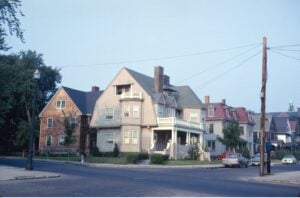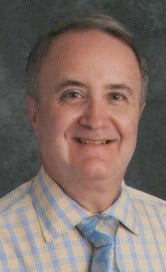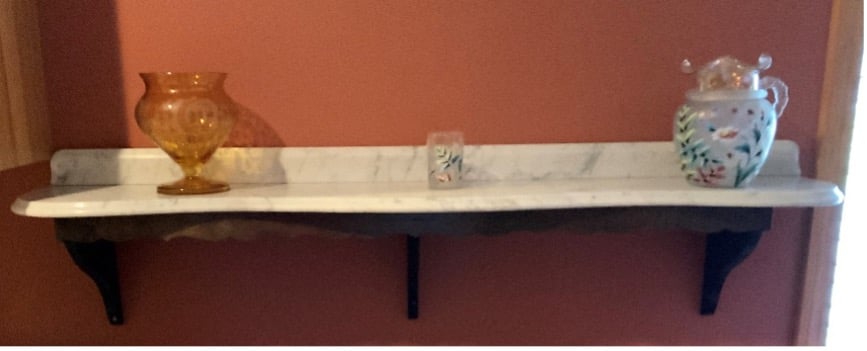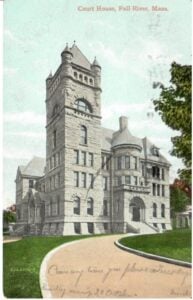 360 Prospect Street, Fall River, Massachusetts, 1962. The houses to the right have been torn down or moved. The cupola of Sacred Heart Academy, far right, is another demolished building.
360 Prospect Street, Fall River, Massachusetts, 1962. The houses to the right have been torn down or moved. The cupola of Sacred Heart Academy, far right, is another demolished building.
In the summer of 1962, when I was three, my parents bought their first home on the corner of Prospect Street and Highland Avenue in Fall River, Massachusetts. They paid $9,500! The house had 13 rooms, four fireplaces, two heating systems, servant call buttons – and my favorite device for childhood eavesdropping, speaking tubes (literally pipes through the walls). All light fixtures had combination gas jets and light bulbs. Like many substantial homes of the late Victorian era, a separate enclosed servants’ staircase went from the cellar to the third floor. That portion of the house had never been renovated, the carpeting on the stairs worn thin.
Growing up here fueled my curiosity about the first occupants of the house. Our neighbor immediately to the north (left side of photo), the late Walter Fraze, told my parents several stories about prior owners. First, he said that Frank L. Allen, owner of a lumber mill, built the house in 1897. Its original address was on Highland Avenue, but Allen changed it to 360 Prospect Street to avoid higher taxes. Frazes’ house, whose interior mimicked ours, was the product of a family feud, “built for spite.” All these stories later proved incorrect.
Next door, proceeding to the east at 376 Prospect Street, was the Second Empire home of Clara Davol, whom I remember as a frail old lady sitting in a window, her full-time nurse always near her side. Clara told my mother that the framing of our house had been finished in time for a torchlight parade up Highland Avenue honoring the election of William McKinley. When Clara died in 1963, my parents bought the Davol property and divided the back yard with the Frazes. My father planned to make his physician’s office on the first floor of the house and rent the second and third floors. After consulting with an architect, curiously a distant relative of the Davols, my parents were advised to tear down the Davol house “because it needed too much work.” All that remains of the Davol house today are two repurposed marble fireplace mantels that followed us to Vermont.
I learned more about the Davols and their extended family by locating their graves in Oak Grove Cemetery, whose entrance was at the head of Prospect Street. Wanting to learn more about our neighborhood house histories, I asked our family lawyer how I would go about doing that. “Simple,” he answered. “Just go to the Registry of Deeds and find the grantor and grantee indexes.”
At age of eleven, used to going just about anywhere on foot within several miles from home, I walked the five blocks down the hill to the Bristol County Courthouse, Southern Registry of Deeds. Thus began a lifetime attraction to registries! Everyone on that day was more than gracious, even asking me if I needed help carrying the indexes. Certainly, I must have been a curiosity. It took several weeks to assemble all the puzzle pieces. The original tract of land extending from Prospect Street to Highland Avenue belonged to banker Abner Davol, Clara’s father. He sold what became my parents’ house and lot to his niece-by-marriage, Mrs. Melvin Horton, née Louise Buffington. Louise lived on Prospect Street through the late 1950s. Abner Davol also sold what became the Frazes’s parcel to another niece who, in turn, sold it to Frank L. Allen, owner of the lumber yard. Years later, after pulling out a dining room buffet drawer and turning it over, I learned that Allen supplied all the woodwork for our house.
“Some frugal Yankees just did not want big yards.”
I also had the benefit of walking to the Fall River Historical Society, just three blocks away, and accessing its collection of city directories. Our family home was not built in 1897, but rather framed by William McKinley’s second inauguration in 1901. Another remarkable source connected to the early days of the house was the curator of the Fall River Historical Society, Florence C. Brigham (1899–2000), who knew the Hortons. She assured me there was no family feud in the division of the properties: “Some frugal Yankees just did not want big yards.”
My parents sold the Fall River house in 2005; by then the view had completely changed, with the expansion of Charlton Memorial Hospital’s parking lot and garage. Knowing who once lived in the neighborhood has added to the richness of my memories and appreciation of local history. I have a genealogy file on the Davol family.
Compared to the slow way I once acquired information on foot, I remain astonished at what we can learn today with the click of a mouse. Nonetheless, I cherish the memories of all those helpful people at the registry who helped a youngster learn lifelong research skills.
Share this:

About Michael Dwyer
Michael F. Dwyer first joined NEHGS on a student membership. A Fellow of the American Society of Genealogists, he writes a bimonthly column on Lost Names in Vermont—French Canadian names that have been changed. His articles have been published in the Register, American Ancestors, The American Genealogist, The Maine Genealogist, and Rhode Island Roots, among others. The Vermont Department of Education's 2004 Teacher of the Year, Michael retired in June 2018 after 35 years of teaching subjects he loves—English and history.View all posts by Michael Dwyer →

